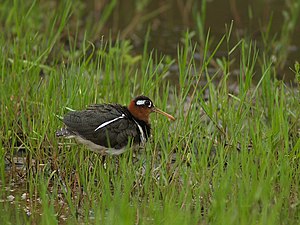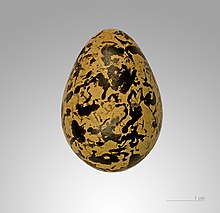Colored goldcock
| Colored goldcock | ||||||||||
|---|---|---|---|---|---|---|---|---|---|---|

Female of the great goldcock ( Rostratula benghalensis ) |
||||||||||
| Systematics | ||||||||||
|
||||||||||
| Scientific name of the genus | ||||||||||
| Rostratula | ||||||||||
| Vieillot , 1816 | ||||||||||
| Scientific name of the species | ||||||||||
| Rostratula benghalensis | ||||||||||
| ( Linnaeus , 1758) |
The golden snipe ( Rostratula benghalensis ) or short woodcock is one of two species from the family of golden snipes . It is widespread in Africa , Asia and Australia and is one of the few birds in which the females are dominant and the males take on the tasks of hatching and rearing young.
The Australian great goldcock ( Rostratula australis ), which occurs in Australia , was classified as a subspecies of the great goldcock until 2008, but is now considered a separate species.
features
The golden snipe reaches a body length of 23 to 28 cm, a wingspan of 50 to 55 cm and weighs 90 to 200 grams. The long, beige beak ends in a widened, red hook. The body has a rounded shape, the forehead rises very steeply from the beak. The legs are strong and end in three long, clawed toes and a short, fourth toe ( anisodactyl foot ). Both sexes have a much lighter color around the eye.
The sexes differ in size and especially in plumage. The female has a maroon neck and head, the wings are closely striped black and gold. A black-lined, white stripe runs between the torso and neck, the underside is also white. The large black eyes are surrounded by a light ring, a strip of which extends over the cheek. The eye ring is also framed by a dark band.
The male has a simple plumage. The neck is more contrasting, the throat also shows shades of white, and the head is dark. The eye ring is also darker and runs out in a light brown tear strip. The wings and back are predominantly light brown. The young birds are similar to the males, but are more pale reddish brown around the eye. The top of the body is gray-brown, the individual feathers have strong red-brown tips. The throat is white, the front breast is washed with brown. The beak is initially darker in the young birds.
distribution
The golden snipe lives on three continents. In Africa they are mainly found south of the Sahara, but a small isolated population lives in northern Egypt along the Nile Valley, in Wadi el-Natrun and in the Al-Fayyum district . Also Madagascar is part of the circulation area of the Greater Painted-Snipe. The species is disjointly distributed here and rare, especially in the south of the peninsula. There is also evidence of breeding for Israel, where the Northern Goldcock are also occasionally overwintering. The species has been observed as a stray visitor in Iran, Oman and Yemen.
The Asian populations live from the far east of Pakistan via India , Bangladesh and Myanmar to Southeast Asia, as well as in southern and eastern China , in southern Japan and the Primorye region . Also in the Philippines as well as the islands of Malaysia and Indonesia the great goldcock is widespread, but eastwards only up to the Wallace Line .
Apart from the resident birds in Egypt, the South African Cape region and Madagascar, the African goldcock are partial nomadic migrants. They avoid completely flooded wetlands, so they migrate depending on the rainfall. For example, golden snipes leave Zimbabwe at the height of the rainy season, whereas in Nigeria they follow the rains and colonize wetlands here until they have dried up to such an extent that they no longer offer suitable habitats for the golden snipe. The common goldcock are also able to quickly colonize wetlands in otherwise unsuitable regions after unusually heavy rainfall. This could be observed, for example, in the very rainy summer of 1999/2000 in Botswana.
habitat
The habitat of the great goldcock are wetlands with open ponds, silt areas and dense floating vegetation. They are most often found in bodies of water whose water level falls due to the onset of the dry season, so that silt areas fall freely, and which have dense vegetation on the water's edges. Such habitats can occur both inland and in coastal waters. They also use the banks of slowly flowing rivers and the banks of lakes. They also use man-made habitats along sewage fields, dykes, irrigation ditches and rice fields.
Way of life
activity
The golden snipe is active at twilight, even at night on moonlit nights. The birds lead a hidden life and are difficult to observe. If an enemy is nearby, they remain motionless in a crouched position. They only blow up in extreme danger.
food
As an omnivore, the goldencock eats both animal and vegetable food. Invertebrates provide food for the animals, for example aquatic insects, snails, worms and crustaceans. Grasses predominate among the plants, including cultivated species such as rice. To search for food, the muddy ground is examined with the beak. The birds are constantly walking around.
Reproduction
There is an inverse sexual dimorphism in the great goldcock , which means that the females assume a dominant position. Usually polyandry prevails , only if the population density is low also monogamy . The mating season is different depending on the area, in southern Africa it is from August to November, in West Africa from March to June, in Asia and Australia broods have been observed all year round. The nests are simple hollows that are padded with soft plant parts.
The female mates with two to four males. It then lays two to five, usually four eggs in each nest. The further breeding business is left to the male - only in monogamous couples there is a division of tasks. The brood lasts 15 to 21 days. The young are fleeing nests , their plumage is light to gray-brown and has dark stripes. They fledge after three to four weeks. The birds reach sexual maturity after one (male) to two (female) years.
supporting documents
literature
- Richart Chandler: Shorebirds of the Northern Hemisphere. Christopher Helm Publishing House, London 2009, ISBN 978-1-4081-0790-4 .
- Josep del Hoyo et al .: Handbook of the Birds of the World. Volume 3: Hoatzins to Auks. Lynx Edicions, 1996, ISBN 84-87334-20-2 .
- Simon Delany, Derek Scott, Tim Dodman, David Stroud (Eds.): An Atlas of Wader Populations in Africa and Western Eurasia. Wetlands International , Wageningen 2009, ISBN 978-90-5882-047-1 .
- Bernhard Grzimek : Grzimeks Tierleben Vögel 2. Deutscher Taschenbuch Verlag GmbH & Co.KG, Munich 1968.
Web links
- BirdLife factsheet
- Rostratula benghalensis inthe IUCN Red List of Threatened Species 2013.2. Listed by: BirdLife International, 2012. Retrieved January 14, 2014.


